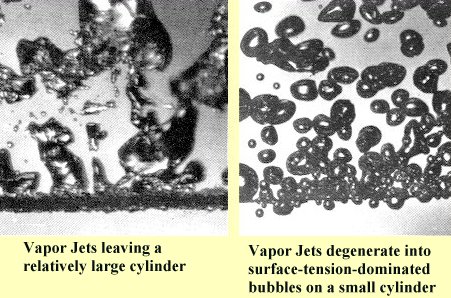On Trying to See
Today, we try to see what we're looking at. The University of Houston's College of Engineering presents this series about the machines that make our civilization run, and the people whose ingenuity created them.
How we turn things to the light makes all the difference. We look at the external world and don't always see the same thing. Try a personal example: Years ago, I studied heat removal from cylindrical heaters in water. That's important where intense heating occurs in, say, nuclear reactors, quenching, or solar furnaces.
As we release more energy from a heater, the water boils, and heat escapes by spurting away in jets of vapor. We can remove as much as a megawatt of energy per square meter of the heater's surface. But, after that, the jets abruptly become unstable and collapse. The cooling path is lost, and the heater suffers a meltdown.
I was trying to write a theory for the way diameter affected that breakdown. So I stared at heaters lit by a blinking strobe light. The smaller the heater, the more erratic and unpredictable the breakdown became. I kept refining experiments, trying to make sense of them. But the data were always inconsistent.
Now I also happened to be studying surface tension. I began to see how surface tension dominates small systems. I should've quit thinking about jets and started looking at how beads of dew behave on spider webs. The penny finally dropped. Surface tension was clamping the jet-like escape paths shut on small heaters.
I'd been seeing jets because I expected to see jets. What I was really seeing were beads of vapor. I'd been chasing vapor in more ways than one. Heat was being carried away, not by jets, but by randomly flickering vapor blobs. When I finally saw what I was looking at, I was no longer looking at the same thing.
That's the perennial story of invention. I bring you this variant only because of something that happened last week. An angry web-surfer found a program I'd done on racism. He wrote to say that the intellectual superiority of the white race was obvious. My denial of it was cowardly political correctness.
This is another place where we've stared at data shaped by our own expectations. We've measured skulls and thrown out data that didn't look right. We've written IQ tests based on the knowledge in our own heads. We've measured relative educational levels of people who were, for centuries, kept out of schools, and so forth.
The closer we look, the more our very definitions of race vaporize into differences we've created in our minds. Remove our a priori expectations and the very concept of race evaporates. You cannot consistently define it by genetics, anatomy, color, or the shape of features. We look at a person and see jets instead of bubbles only because we expect to see them.
This is an old and sad story: We discover only when we see through the vapor and open ourselves to surprise. The very word prejudice means determining an outcome before we let the facts surprise us. That's what Louis Pasteur meant when he warned us that,
In the field of observation,
chance favors the prepared mind.
I'm John Lienhard, at the University of Houston, where we're interested in the way inventive minds work.
(Theme music)
You may find a textbook discussion of the boiling "burnout" problem in Chapter 9 of A Heat Transfer Textbook (available free of charge online at: http://web.mit.edu/lienhard/www/ahtt.html ).
For a major review article about burnout on cylindrical heaters, see: Lienhard, J. H., Burnout on Cylinders. Journal of Heat Transfer, Vol. 11, No. 4(B), (50th Anniversary Issue) Nov. 1988, pp.1271-86.
Stephen J. Gould provides excellent background on the issue of racism. See, e.g., Gould, S.J., The Mismeasure of Man. New York: W.W. Norton & Co., 1981, and Gould, S.J., The Flamingo's Smile: Reflections in Natural History. New York: W.W. Norton & Co., 1985.

Sun and Lienhard, Int. J. Ht. Mass Tr., Vol. 12, 1970, pp. 1425-1439